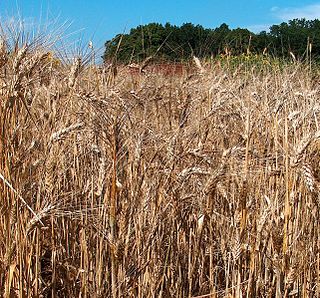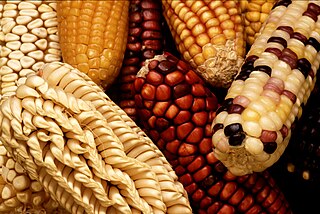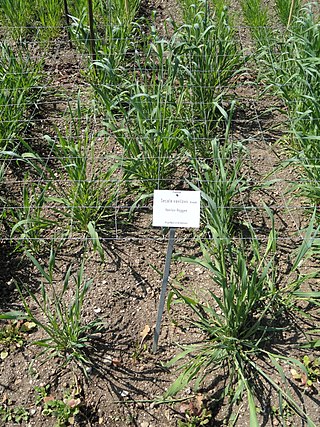Related Research Articles

The potato is a starchy root vegetable native to the Americas that is consumed as a staple food in many parts of the world. Potatoes are tubers of the plant Solanum tuberosum, a perennial in the nightshade family Solanaceae.

Wheat is a grass widely cultivated for its seed, a cereal grain that is a staple food around the world. The many species of wheat together make up the genus Triticum ; the most widely grown is common wheat. The archaeological record suggests that wheat was first cultivated in the regions of the Fertile Crescent around 9600 BC. Botanically, the wheat kernel is a caryopsis, a type of fruit.

In agriculture, monoculture is the practice of growing one crop species in a field at a time. Monoculture is widely used in intensive farming and in organic farming: both a 1,000-hectare cornfield and a 10-ha field of organic kale are monocultures. Monoculture of crops has allowed farmers to increase efficiency in planting, managing, and harvesting, mainly by facilitating the use of machinery in these operations, but monocultures can also increase the risk of diseases or pest outbreaks. This practice is particularly common in industrialized nations worldwide. Diversity can be added both in time, as with a crop rotation or sequence, or in space, with a polyculture or intercropping.

Durum wheat, also called pasta wheat or macaroni wheat, is a tetraploid species of wheat. It is the second most cultivated species of wheat after common wheat, although it represents only 5% to 8% of global wheat production. It was developed by artificial selection of the domesticated emmer wheat strains formerly grown in Central Europe and the Near East around 7000 BC, which developed a naked, free-threshing form. Like emmer, durum wheat is awned. It is the predominant wheat that grows in the Middle East.

Genetic diversity is the total number of genetic characteristics in the genetic makeup of a species. It ranges widely, from the number of species to differences within species, and can be correlated to the span of survival for a species. It is distinguished from genetic variability, which describes the tendency of genetic characteristics to vary.

A landrace is a domesticated, locally adapted, often traditional variety of a species of animal or plant that has developed over time, through adaptation to its natural and cultural environment of agriculture and pastoralism, and due to isolation from other populations of the species. Landraces are distinct from cultivars and from standard breeds.

Agricultural biodiversity or agrobiodiversity is a subset of general biodiversity pertaining to agriculture. It can be defined as "the variety and variability of animals, plants and micro-organisms at the genetic, species and ecosystem levels that sustain the ecosystem structures, functions and processes in and around production systems, and that provide food and non-food agricultural products.” It is managed by farmers, pastoralists, fishers and forest dwellers, agrobiodiversity provides stability, adaptability and resilience and constitutes a key element of the livelihood strategies of rural communities throughout the world. Agrobiodiversity is central to sustainable food systems and sustainable diets. The use of agricultural biodiversity can contribute to food security, nutrition security, and livelihood security, and it is critical for climate adaptation and climate mitigation.

Phaeosphaeria nodorum is a major fungal pathogen of wheat, causing the disease Septoria nodorum blotch. It is a member of the Dothideomycetes, a large fungal taxon that includes many important plant pathogens affecting all major crop plant families.
Marker assisted selection or marker aided selection (MAS) is an indirect selection process where a trait of interest is selected based on a marker linked to a trait of interest, rather than on the trait itself. This process has been extensively researched and proposed for plant- and animal- breeding.
Crop diversity or crop biodiversity is the variety and variability of crops, plants used in agriculture, including their genetic and phenotypic characteristics. It is a subset of a specific element of agricultural biodiversity. Over the past 50 years, there has been a major decline in two components of crop diversity; genetic diversity within each crop and the number of species commonly grown.
In genetics, association mapping, also known as "linkage disequilibrium mapping", is a method of mapping quantitative trait loci (QTLs) that takes advantage of historic linkage disequilibrium to link phenotypes to genotypes, uncovering genetic associations.

Plant breeding is the science of changing the traits of plants in order to produce desired characteristics. It has been used to improve the quality of nutrition in products for humans and animals. The goals of plant breeding are to produce crop varieties that boast unique and superior traits for a variety of applications. The most frequently addressed agricultural traits are those related to biotic and abiotic stress tolerance, grain or biomass yield, end-use quality characteristics such as taste or the concentrations of specific biological molecules and ease of processing.
Plant breeding started with sedentary agriculture, particularly the domestication of the first agricultural plants, a practice which is estimated to date back 9,000 to 11,000 years. Initially, early human farmers selected food plants with particular desirable characteristics and used these as a seed source for subsequent generations, resulting in an accumulation of characteristics over time. In time however, experiments began with deliberate hybridization, the science and understanding of which was greatly enhanced by the work of Gregor Mendel. Mendel's work ultimately led to the new science of genetics. Modern plant breeding is applied genetics, but its scientific basis is broader, covering molecular biology, cytology, systematics, physiology, pathology, entomology, chemistry, and statistics (biometrics). It has also developed its own technology. Plant breeding efforts are divided into a number of different historical landmarks.

Thinopyrum obtusiflorum is a species of grass known by the common names tall wheatgrass, rush wheatgrass, and Eurasian quackgrass. It is native to Eurasia and it has been introduced to many other parts of the world, including much of the Americas and Australia.
The Germplasm Resources Unit is part of the John Innes Centre. Located in the Norwich Research Park, Norwich, England, is a germplasm conservation unit and National Capability supported by the Biotechnology and Biological Sciences Research Council. This unit houses a number of internationally recognised reference- and working-collections for wheat, oats, barley and peas, which serves UK and non-UK based academic, industrial and non-industrial groups.
Plant–fungus horizontal gene transfer is the movement of genetic material between individuals in the plant and fungus kingdoms. Horizontal gene transfer is universal in fungi, viruses, bacteria, and other eukaryotes. Horizontal gene transfer research often focuses on prokaryotes because of the abundant sequence data from diverse lineages, and because it is assumed not to play a significant role in eukaryotes.

Edward S. Buckler is a plant geneticist with the USDA Agricultural Research Service and holds an adjunct appointment at Cornell University. His work focuses on both quantitative and statistical genetics in maize as well as other crops such as cassava. He originated the concept of Nested association mapping and created the first population designed for this type of quantitative genetic analysis. Buckler was elected an American Association for the Advancement of Science Fellow in 2012. In 2014, he was elected to the National Academy of Sciences. In 2017, he received the NAS prize in Food and Agricultural Science for his work using natural genetic diversity to develop varieties of maize with fifteen times more vitamin A than existing varieties.
Ernest Robert Sears was an American geneticist, botanist, pioneer of plant genetics, and leading expert on wheat cytogenetics. Sears and Sir Ralph Riley (1924–1999) are perhaps the two most important founders of chromosome engineering in plant breeding.

Secale vavilovii is a species of grass, native to Turkey, the Transcaucasus, Iraq, and Iran. An annual, it is a crop wild relative of rye and is being studied for its resistance to Fusarium ear blight and Septoria leaf blotch.
Arthur Ernest Watkins was an English botanist known for his foundational work in plant genetics.
References
- ↑ "Watkins landrace collection resource for bread wheat". Agri-TechE. 29 July 2014. Retrieved 2 February 2024.
- 1 2 Halder, Jyotirmoy; Zhang, Jinfeng; Ali, Shaukat; Sidhu, Jagdeep S.; Gill, Harsimardeep S.; Talukder, Shyamal K.; Kleinjan, Jonathan; Turnipseed, Brent; Sehgal, Sunish K. (8 November 2019). "Mining and genomic characterization of resistance to tan spot, Stagonospora nodorum blotch (SNB), and Fusarium head blight in Watkins core collection of wheat landraces". BMC Plant Biology. 19 (1): 480. doi: 10.1186/s12870-019-2093-3 . PMC 6839225 .
- 1 2 Burt, C.; Griffe, L. L.; Ridolfini, A. P.; Orford, S.; Griffiths, S.; Nicholson, P. (December 2014). "Mining the Watkins collection of wheat landraces for novel sources of eyespot resistance". Plant Pathology. 63 (6): 1241–1250. doi: 10.1111/ppa.12221 .
- 1 2 Aradottir, G.I.; Martin, J.L.; Clark, S.J.; Pickett, J.A.; Smart, L.E. (March 2017). "Searching for wheat resistance to aphids and wheat bulb fly in the historical Watkins and Gediflux wheat collections". Annals of Applied Biology. 170 (2): 179–188. doi:10.1111/aab.12326. PMC 5324697 . PMID 28303034.
- ↑ Wingen, Luzie U.; Orford, Simon; Goram, Richard; Leverington-Waite, Michelle; Bilham, Lorelei; Patsiou, Theofania S.; Ambrose, Mike; Dicks, Jo; Griffiths, Simon (August 2014). "Establishing the A. E. Watkins landrace cultivar collection as a resource for systematic gene discovery in bread wheat". Theoretical and Applied Genetics. 127 (8): 1831–1842. doi:10.1007/s00122-014-2344-5. PMC 4110413 .
- ↑ Zafeiriou, Petros; Savva, George M.; Ahn-Jarvis, Jennifer H.; Warren, Frederick J.; Pasquariello, Marianna; Griffiths, Simon; Seung, David; Hazard, Brittany A. (6 January 2023). "Mining the A.E. Watkins Wheat Landrace Collection for Variation in Starch Digestibility Using a New High-Throughput Assay". Foods. 12 (2): 266. doi: 10.3390/foods12020266 . PMC 9858048 .
- ↑ Watkins, A. E. (July 1925). "Genetic and cytological studies in wheat. II". Journal of Genetics. 15 (3): 323–366. doi:10.1007/BF02983124. S2CID 44654409.
- ↑ Koebner, Robert (August 2023). "Arthur Ernest Watkins: Geneticist and Collector" (PDF). The Genetics Society (89): 24.
- ↑ "Dr Harold Howard". Maris Piper. 30 January 2016.
- ↑ Watkins, A. E. (March 1933). "The Origin of Cultivated Plants". Antiquity. 7 (25): 73–80. doi:10.1017/S0003598X0000764X. S2CID 164202493.
- ↑ D., C. D. (January 1936). "Heredity and Evolution". Nature. 137 (3453): 7. Bibcode:1936Natur.137....7C. doi: 10.1038/137007a0 . S2CID 38792194.
- ↑ Watkins, Arthur Ernest (1930). The Wheat Species; a Critique by A.E. Watkins. University Press. p. 263.